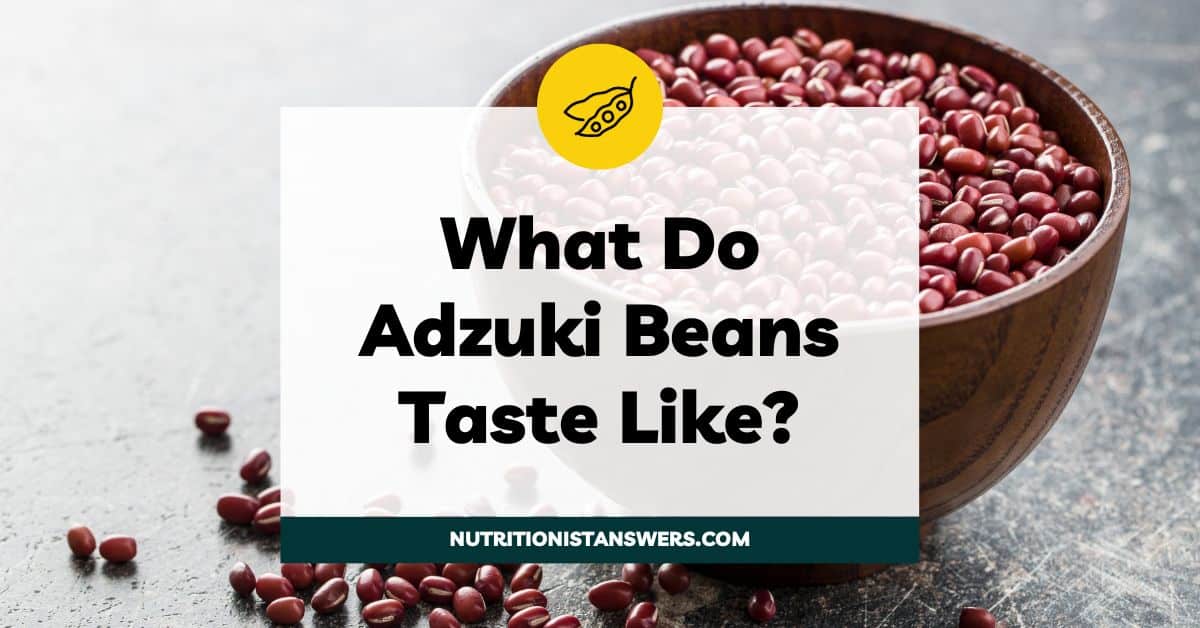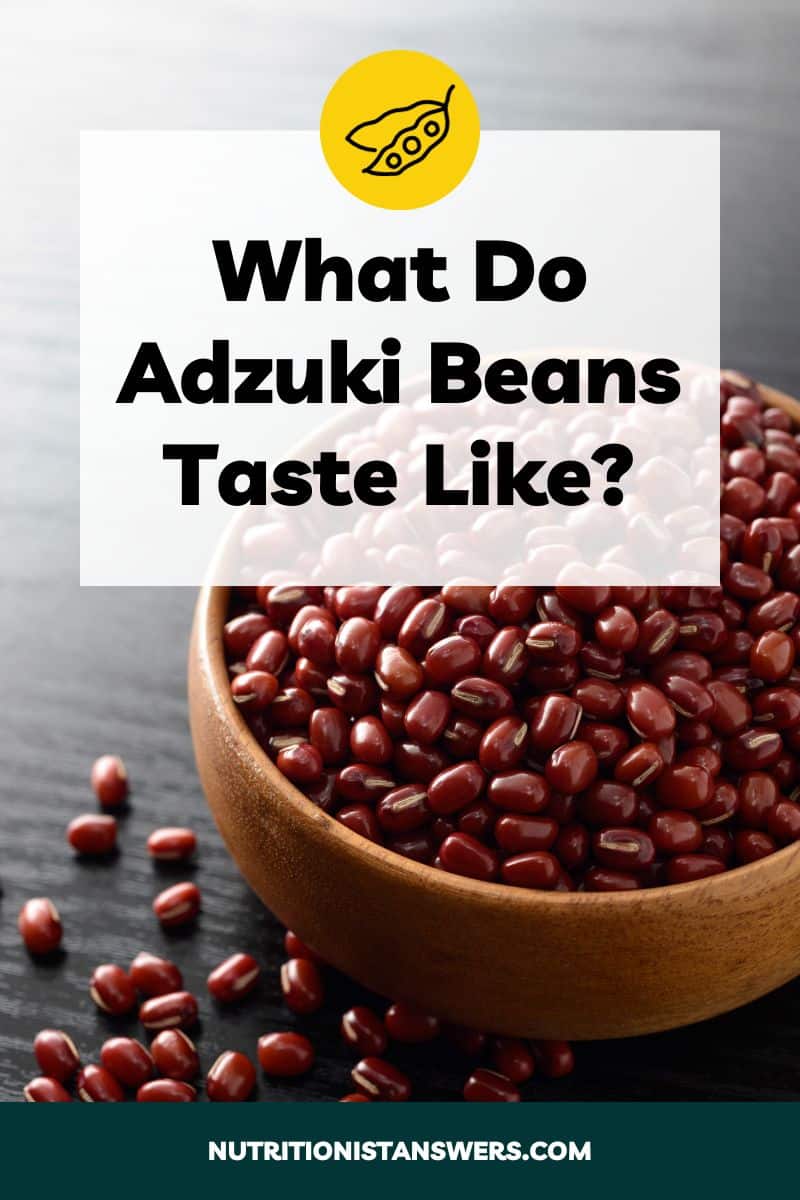Adzuki beans (also known as azuki or red beans) are a mainstay of Asian cuisine, found in everything from soups and stews to rice dishes and desserts like mochi and mooncakes.
If you’ve never had the opportunity to try them, you might be wondering what adzuki beans taste like and how they’re different from other beans.
Let’s delve into the flavor profile of adzuki beans, their nutritional value, and ways to use them in your favorite dishes.

Please note that this article contains affiliate links. If you click one of these links and make a purchase, we may earn a commission. As an Amazon Associate, we earn from qualifying purchases.
What do adzuki beans taste like?
Adzuki beans have a nutty, earthy flavor with a subtle sweetness. Their texture is soft and creamy, but they maintain their shape when cooked.
Are adzuki beans naturally sweet?
Azuki beans are mildly sweet, but they are commonly cooked and mixed with equal amounts of sugar to make sweet red bean paste, which is used in many Asian desserts.
The sweetness you taste in red bean paste desserts is mostly from the added sugar, not from the azuki beans themselves.
What are adzuki beans?
Adzuki beans (also azuki or red beans) are small, red beans that originated in China and are very popular in Asian cooking (1).
They are smaller than many other beans, measuring about 5-6 mm in length, and have dark, reddish-brown skin with a thin white line along one side.
Available dried, canned, or as a bean paste, adzuki beans can be found at Asian grocery stores, health food markets, and some supermarkets (often labeled as “small red beans”).
Adzuki beans are commonly used in both sweet and savory dishes. They are a key ingredient in many Asian desserts and can also be added to soups, stews, and rice dishes.
Adzuki bean nutrition
Adzuki beans are high in carbohydrates, of which about 40% are fiber, and provide a good amount of protein. They contain almost no fat and are naturally low in sodium.
Here’s a more detailed breakdown of adzuki bean nutrition:
Calories and macronutrients
Here’s the macronutrient content for a half cup (115 grams) of cooked adzuki beans (2):
- Calories: 147
- Carbohydrates: 29 grams
- Fiber: 8 grams
- Protein: 9 grams
- Fat: <0.5 grams
Azuki beans are high in carbohydrates, but 40% of the carbs are fiber, which is great for digestive health. They also contain a good amount of protein, a few grams more per serving than most other beans.
Vitamins and minerals
Here’s the vitamin and mineral content for a half cup (115 grams) of cooked adzuki beans (2):
- Copper: 0.34 mg (38% DV)
- Folate: 139 mcg (35% DV)
- Manganese: 0.7 mg (30% DV)
- Zinc: 2 mg (18% DV)
- Phosphorus: 193 mg (15% DV)
- Magnesium 60 mg (14% DV)
- Potassium: 610 mg (13% DV)
- Iron: 2.3 mg (13% DV)
- Thiamin: 0.13 mg (11% DV)
- Pantothenic acid: 0.5 mg (10% DV)
- Niacin: 1 mg (6% DV)
- Vitamin B6: 0.1 (6% DV)
- Riboflavin: 0.07 mg (5% DV)
- Calcium: 32 mg (2% DV)
- Selenium: 1 mcg (2% DV)
- Sodium: 9 mg (<1% DV)
High in B vitamins: Adzuki beans are a rich source of B vitamins, providing at least 10% of the Daily Value (DV) for folate, thiamin, and pantothenic acid in a half-cup serving.
Excellent source of copper and manganese: Just a half cup of adzuki beans provides 38% and 30% of your daily needs for copper and manganese, respectively.
Good source of many other minerals: Like other beans, adzuki beans are packed with minerals. A half-cup serving offers at least 10% of the DV for zinc, phosphorus, magnesium, potassium, and iron.
Where to buy adzuki beans
Adzuki beans are most likely to be found at Asian grocery stores and health food markets but are also sometimes available at supermarkets. You can find them dried, canned, or as a bean paste.
Here are some of the most popular adzuki bean products available on Amazon:
- Food To Live Organic Adzuki Beans
- Yupik Organic Adzuki Beans
- Eden Organic Adzuki Beans
- Fusion Select Red Bean Paste
How to cook adzuki beans
To cook dried adzuki beans, start by soaking them for 8 hours or overnight in plenty of water. This rehydrates the beans and helps them cook more evenly (3).
After soaking, drain and rinse the beans, then place them in a large pot of fresh water. The general rule of thumb is to use approximately 3 cups of water for every 1 cup of dried adzuki beans.
Bring the water to a boil, and then reduce the heat to a simmer. Cover the pot and let the beans cook for about 45 minutes to 1 hour, or until they are tender.
When they are finished cooking, drain the adzuki beans and use them immediately or store in the refrigerator until ready to use.
How to store adzuki beans
Dried adzuki beans should be stored in a dark, cool place such as a pantry or cabinet. They can be used after the expiration date, but you might notice a decrease in freshness and quality (4).
Canned adzuki beans can be stored (unopened) at room temperature in a cabinet or pantry. They will stay fresh for 2-5 years but can also be used past the expiration date (5).
Cooked adzuki beans should be stored in the refrigerator and used within 3-4 days (6). You can also freeze them in an airtight container for long-term storage.
Ways to use adzuki beans
1. In dips and spreads
Adzuki beans can be a delightful addition to dips and spreads, offering a unique flavor and a boost of protein and fiber.
One option is to create a creamy adzuki bean hummus. Simply blend cooked adzuki beans with tahini, garlic, lemon juice, and olive oil for a nutty and slightly sweet twist on traditional hummus.
The adzuki beans’ slightly sweet and nutty flavor pairs well with various herbs and spices, so don’t be afraid to experiment with different seasoning combinations to suit your taste preferences.
2. In soups, stews, and curries
Adzuki beans can be added to just about any soup, stew, or curry dish, providing an earthy, nutty flavor and creamy texture.
Adzuki beans pair well with chicken broth or tomato-based soups and stews that feature vegetables like sweet potatoes, carrots, mushrooms, and leafy greens.
In curries, adzuki beans complement ingredients like coconut milk, tomatoes, and spices such as cumin and coriander. Serve them alongside rice or quinoa for a filling and nutritious meal.
3. In stir-fries and rice dishes
Adzuki beans are a fantastic way to boost the protein, fiber, and mineral content of your favorite stir-fries and rice dishes.
In stir-fries, you’ll want to add cooked adzuki beans toward the end of cooking to prevent them from becoming mushy. They pair well with soy-based sauces and vegetables like bell peppers and broccoli.
For rice dishes, adzuki beans are typically cooked separately, then added to the rice as it cooks. Try Japanese sekihan (red bean rice) for an easy recipe.
4. In baked goods and desserts
Adzuki bean paste is a fundamental ingredient in many Asian desserts and baked goods. It is also called sweet red bean paste, “anko” (in Japanese), or “hong dou sha” (in Chinese).
To make it, cooked adzuki beans are mashed with a fork or blended until smooth, then sweetened with sugar. Sometimes butter, oil, or flavorings are also added to the paste.
You’ll find red bean paste in traditional Chinese and Japanese desserts like mochi, fried sesame balls, mooncakes, bao, anpan, and yokan. It’s also used as a flavoring for ice cream.
Final thoughts
Adzuki beans are small, red beans with a nutty, earthy flavor and just a hint of sweetness. Their texture is soft and creamy, but they maintain their shape when cooked.
Like other legumes, adzuki beans are incredibly nutrient-rich. A half cup of cooked adzuki beans offers 29 grams of carbs (including 8 grams of fiber), 9 grams of protein, and almost no fat.
They’re also high in B vitamins and minerals, providing at least 10% of the DV for folate, thiamin, and pantothenic acid, as well as one-third of your daily needs for copper and manganese.
Overall, adzuki beans are an excellent plant-based protein option and a versatile ingredient that can be used in a wide range of dishes, both sweet and savory.
Amy Richter is a Registered Dietitian Nutritionist based in Missouri. She is an experienced nutrition writer and medical advisor for Healthline and Medical News Today. Amy is passionate about all things food-related and enjoys translating complex science into easy-to-understand articles.


